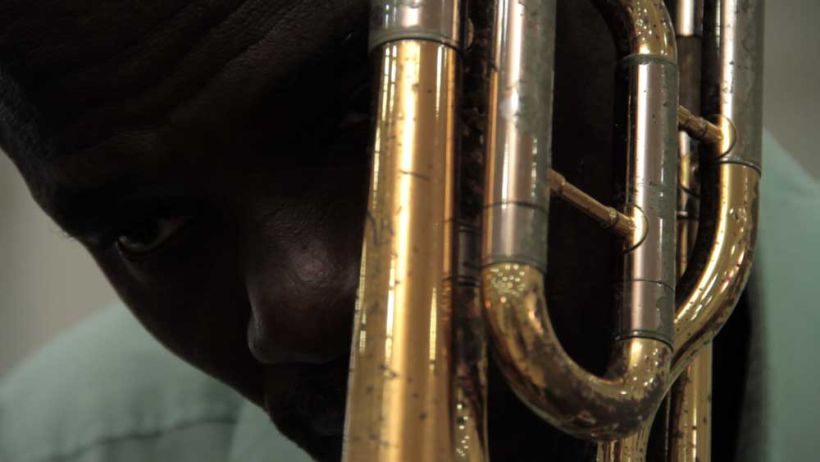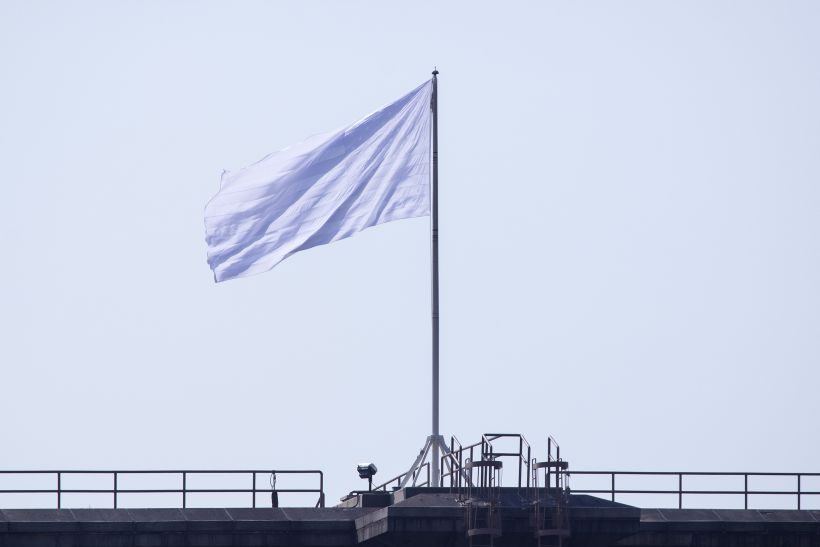This text is an abridged version of the talk which the author gave on 8 December 2016 as part of “Short of What?” – the one-day short film event organised by Matthias Müller and Daniel Burkhardt and held at the Academy of Media Arts Cologne.
In this text, the intention is not to show that the short film format is especially political, nor to reveal the extent to which it may be so, nor whether it is any more political than other filmic formats. Instead, I would like to discuss, on the basis of the three examples provided, in which way these films, on the one hand, engage with politics in terms of their content and, on the other hand, how they have become political themselves with regard to the way and manner in which they were produced and are presented. My focus here is on the creation of community by means of specific forms of aesthetic experience and thus, firstly, on the performance and presentation formats. It is concerned with interventions in public spaces, as well as with those medial spaces which are connected to them and, thus, secondly, with possibilities of infiltration. And, finally, it is concerned with the issue of how film is able to narrate political reality, and thus, thirdly, with forms of fabrication.
1. Performance

My Lifetime( Malaika) © Katarina Zdjelar
In Katarina Zdjelar’s video piece MY LIFETIME (MALAIKA), we attend a rehearsal by the National Symphony Orchestra Ghana, which was founded during the country’s independence at the end of the 1950s. It was intended as an expression of a new national awareness, one which should emphatically mark Ghana’s entrance into a modern, international culture, thereby abandoning the traditional practice of art in the country, which was especially participatory. For the first time, music was grasped in terms of its national representational function, which should not only communicate to the outside world, but also in an inward sense: With a new musical canon and a new way of practicing art intended to serve as a kind of practical training for a new form of society. The contradictory nature of this plan is clear: Overcoming the colonial order and joining the global community of independent states is being expressed here through the adaption of a model which itself has its basis in the former colonial rulers.
Zdjelar regards colonialism here as a form of politics with a long-term impact, one which is etched into human bodies and articulated by and through them. We see close-ups of the musicians and their instruments, and occasionally of other objects there. Yet a sense of space cannot be inferred from these shots, nor indeed the composition of the interplay. The orchestral ensemble, which we are used to seeing as a perfectly arranged, highly concentrated whole, seems to be fragmented. The musicians creating the sounds are decoupled in some strange way from those very sounds. And in fact it looks like several of them have come too late for their rehearsal, while others fall asleep from exhaustion during the break before the next part they are due to perform. And even the saliva seems to be dripping more sluggishly than normally from the holes in the wind instruments.
The Malaika piece which the orchestra is interpreting is based on a traditional song about an ill-fated love affair due to the destitution of the suitor. The song first made its way into Western pop culture during the 1960s thanks to interpreters such as Miriam Makeba and Harry Belafonte, where it was received as a symbol of an independent African identity. The renewed interpretation of this musical material by the national orchestra permits a tale of reciprocal reflections, appropriations and attacks to emerge, which obliterates the naive notions of some ahistorical, authentic “African”. The traditional Malaika song works here like a syncope, a rhythmic shifting, which has inserted itself into the ensemble playing of the orchestra.
Significantly, the conductor as an arranging entity also remains outside the frame. So who or what is setting the rhythm of the musicians here? Again and again, street noises penetrate into the rehearsal space, as though they want to discreetly evoke that “what is out there”. Everyday life is playing along, with the pace and beat of the work dictating the rhythm of the performance. Even the hands of the musicians seem to hint that they do not live from music but from other concrete, tangible work. Their own exhaustion reflected in the worn-out instruments, which may even come from the period when the orchestra was founded.
The fatigue of the people and the objects indicates that the orchestra now only plays a marginal role in the national self-expression of Ghana and, in line with this, it is chronically underfinanced with its continued existence precarious. The efforts by African states to attain international standards also on a cultural level inevitably fail in the face of the perpetual and systematic impoverishment of the continent, which has its roots in a colonial system of exploitation. And in this sense, the rehearsal by the Ghanaian symphony orchestra is symptomatic. We see no progress in their shared performance. An endless loop unfolds before us, one which boils down to a zero-sum game of incentive and overexertion. An orchestra stuck forever in a preparatory phase of its own performance, permanently offstage. With the self-determined appropriation and transformation of a “Western” tradition running counter to the neo-colonial logic of the charitable gift as a symbol and solidification of existing inequalities. Thus, the highly lauded “concert of nations” can at most serve the African continent as a stage on which the Western “donor nations” can cast themselves as saviours.
“Politics is primarily conflict over the existence of a common stage and over the existence and status of those present (on it).”[1] Zdjelar is indicating this conflict over a common stage here, in that she permits the articulation of differing, contradictory stories and traditions in one and the same human bodies and objects. She has, to a certain extent, provided a temporary stage on which the political can occur and be performed as a conflict of bodies in a community.
2. Infiltration
As a video piece, SYMBOLIC THREATS from Mischa Leinkauf, Lutz Henke and Matthias Wermke occupies an ambivalent place between performance and documentation. For several years now Wermke and Leinkauf, acting as a duo, have developed interventions in public spaces, which they document and exhibit on photos, slides and video works. Yet for that, their practice of art refuses to address the question of where this art actually belongs or what the actual artwork is – the performance or its documentation. Likewise, SYMBOLIC THREATS is based on such an intervention: Overnight, the artists replaced the two American flags on the Brooklyn Bridge in New York with white flags they had sewn themselves. And while the performing of the action itself remained unnoticed, for that their images achieved an even greater impact. I would like to speak here especially about the medial process which this performance triggered off and which became the basis for the video.

Symbolic Threats © Wermke/Leinkauf, 2015
As a rule, performative art assumes the presence of an audience which is being addressed live in that moment. Thus, such works can only have an afterlife as a document, and ideally as an iconic image that attests to the performance in the moment of its occurrence.[2] And the documentation of a performance becomes even more important when a live audience is not desired, as in the case with Wermke and Leinkauf. A performance which no one sees “live”, or a missed action in other words, can only ever first become an event retrospectively. With even the missing of the performance itself becoming the event: How could it happen at all, why was it not seen, and what does that say about those who apparently fail to miss nothing? The subsequent obsessive interpretation in the media of that which had not been viewed was aimed, among others, at rhetorically filling this blank space of power that had evidently arose.
With their performance, Wermke and Leinkauf infiltrated this medial space. Doing so, they did not disturb its processes, but instead fed it with that which it loves most. Martha Rosler’s much quoted statement that early alternative television turned the viewers into co-producers emerges once more here. But in this case however, it is not artists filling TV programme slots with potentially inconvenient, critical content which disrupts the broadcasting routines of the public and private channels. They are the ones firing them on until they become fervent. The artists are supplying the best broadcastable material, which can be stage-managed as a live crime thriller. And once it has been fed into the system, their “case” develops its own subversive dynamic in that, through the images of their performance, it forces the media to also endlessly reproduce their own blind spot.
The artists themselves subsequently undertook the documentation of these medial (over)reactions in their video. The gesture is reminiscent of earlier media-critical video experiments which already complied material from TV formats in the 1970s and where they exposed the production of truth in television doing so. However, something else is revealed in SYMBOLIC THREATS. What we can observe here is the production of an artwork: Its creation arising from the comments, reports and follow-ups by and from the various recipients. What is it that happened there? Art or politics, vandalism or a terrorist act? And who is the author of this message? With a blank space yawning here, the countless interpreters become fellow participants in an artistic process with no centre. They write about its explanations and interpretations without knowing what the piece constitutes, or will once constitute; about a piece that others are allowed to speak about whether it is artistic or political. And what is also being indicated here is that other documentation which has been created parallel to the artists’ video, by which is meant the archive of police and judicial enquiries away from the public eye and related to the investigation of the artwork as a criminal case.
In an ironic way, the intervention by Wermke and Leinkauf has updated the avant-garde promise of having an art form that intervenes in life and blasts open an encrusted status quo through shocks and scandals. And even if this overpowering of the state through artistic means – by occupying its territory and expropriating its symbols – does succeed for a while, it has not however initiated the merging of art and life doing so, as the avant-garde intended. But it certainly does succeed in the sense that for a time, an artistic gesture can claim the energy and attention of the political sphere and the media for itself, becoming incorporated into them as an object of action and discussion, and that especially because it is not clearly identifiable as art, and because the limits of that which can be regarded as art are temporarily suspended here. However, the comments by the police chief in New York as the uppermost interpreter of art and life are also significant: We will only learn upon their (the artists’) arrest what exactly the intervention really was, art or a political act.
3. Fabrication
A freeze-frame television image in a hotel room in Cork: Two weeks after the attack on the World Trade Center in New York and one day after the beginning of the bombardment of Afghanistan by American and British troops, BBC 24 broadcast a news report which paused at 1.41 in the middle of the night. The expert in the shot and the commentary at the edge of the frame froze, with the filmmaker and his camera fixated on and spellbound by this frozen image as he speculates about the reasons why. FROZEN WAR is the first part of John Smith’s HOTEL DIARIES, a series of seven videos in total filmed between 2001 and 2007 in hotel rooms in Cork, Berlin, Winterthur, Bristol, Rotterdam, Bethlehem and Jerusalem when the filmmaker was staying there during festival and guest residencies. They are – with one exception – filmed in a single shot and unfold as a sequence of observations told in passing, which commence in a hotel room as a “found space”, or in other words, as a random ensemble of objects and structural details, so as to go forth from there and propagate themselves and return there repeatedly, as an apparently automated flow of associations.

Frozen War, Hotel Diaries © John Smith, 2001
The impression the video makes is consciously lo-fi, with the camera an amateur device and the sound recorded with the camera’s inbuilt microphone. Smith films as he talks, and we go along with him as he completes his motions and have his voice directly in our ears, as though we ourselves are there with him in this room, where you only speak in a hushed tone so as not to wake up the other hotel guests sleeping at this late hour: In this paradoxical space that purports to allow being at home while in alienation, that attempts to blend global taste and a personal touch, and that simulates comfort and safety while providing information at the same time about the escape routes and exits in the event of an emergency.
It is exactly these paradoxes which reveal the changing hotel rooms as the perfect stage for Smith’s associating narratives. They act as backdrops before which objects are grouped for still-life compositions, ones which only arouse the appearance of having being found. The camera scans and touches them, fixing on individual objects and connecting them into a narrative arc, pursuing the logic of some eye-winking, cheeky paranoia. Yet we sense the invisible hand of the arranger behind all the casualness of the observations and what is being narrated. He is fabricating, creating fictions. Smith is conspiring with a found space and the objects contained within it so as to develop a narrative from and with them, one in which the close entanglements of history and stories are revealed. Doing so, a video chronical is created here in which the trivial becomes the narrative vehicle of the historical.
In Bristol (B&B) for instance, in an American hotel chain which purports to have a traditionally British design, Smith finds intimations of the torture photos from Abu Ghraib in the ornate wall decorations in his hotel room, as well as the rubbish from previous occupants under the bed of this superficially so impeccable establishment. In Smith’s observations, they become legible as traces of the “special relationship” that connects the USA and Great Britain as coalition partners in war. In Bethlehem (DIRTY PICTURES), the loose ceiling tiles in his hotel room, which can be moved by a draught or breeze, gain the emotional impression of a precarious political situation, and the annoying dust particles on his lens become a forestalled commentary on the outrageous Israeli cleansing policy.
And repeatedly, with the hotel window as a hole in the wall become a reference to that ensemble of holes which our houses have become. A window substitute that permits a view of the world that is not only one-sided, but also hopelessly restricted.[3] In this way, Smith permits himself to be recognised as a viewer, but one who himself attempts to visualise the political events out there, which can barely be surveyed. As a filmmaker, he does not exert himself in order to acquire facts, but instead searches in that which is evident and close at hand for images of his own insecurity. That he has chosen the series format in order to do so is not only a reference to the claim by television to understand how to depict “reality”, but is also the prerequisite for being able to successively make visible the individual elements in the development of a political situation. Each episode shapes its own narrative space, but one with holes in the wall that not only refer to its own respective exterior, but also to the historical before and after.
Smith is a chronicler who does not permit the events to slumber, because everything is or could be connected to each other. What happens “outside” continues to speak “inside” through those objects that serve as anchor points for his narration. Smith narrates so as to expel the apparent neutrality from the objects. He continues to look until the persistent question that was already plaguing him in Frozen War refuses to let go of us as well: What happened there? It too would be able to rob us of our sleep, were we to look at it exactly.
Or even one step further: If we permit ourselves to be infiltrated by his fabrications and if this infiltration moves us to action, that kind of performance could arise from this which would fulfill the promise of the former avant-garde.
[1] Jacques Rancière: Disagreement. Politics and Philosophy. Minnesota: University of Minnesota Press, 1999, translated by Julie Rose, p 26.
[2] Cf. Barbara Clausen (ed.): After the Act. The (Re)Presentation of Performance Art. Nuremberg: Verlag für Moderne Kunst publisher, 2007.
[3] Cf. Vilém Flusser: Vom Stand der Dinge. Eine kleine Philosophie des Design (Shape of Things: A Philosophy of Design), Göttingen: Steidl, 1993, p 81.